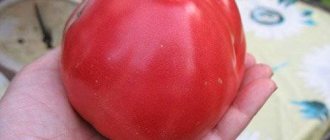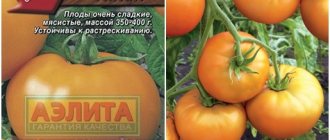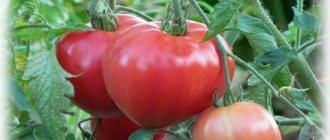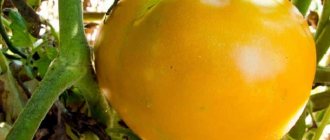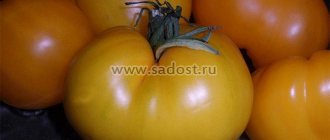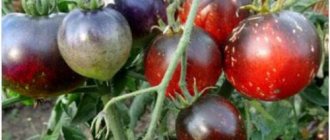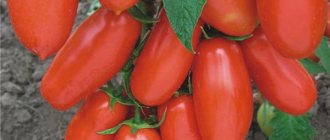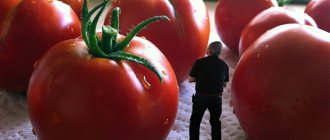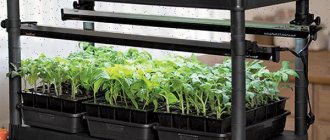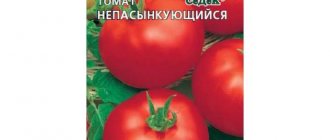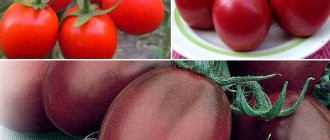Tomatoes are tasty and healthy vegetables that any summer resident grows in his garden. In the 21st century, there are many types and varieties of tomatoes, so everyone can choose a variety that will meet all their expectations according to the description.
| Height | Landing location | Ripening time | Fruit color | Fruit size | Origin | Fruit shape |
| Tall | Greenhouse, Open ground | Late ripening | Reds | Large | Hybrid | Flat-round |
Features of cultivation
The variety has good reviews.
Tomatoes are recommended to be planted as seedlings in open ground. Before planting, the seeds must be disinfected by immersing them in a solution of potassium permanganate. After the procedure, the seeds are washed, dried, and doused with special agents that stimulate growth and increase the number of seedlings. Tomato prefers soil from the garden, where fertilizers or peat are added. Sometimes a small amount of sand or ash is introduced. Containers and small containers with peat are well suited for sowing. If we plant seeds in cups, we need to sprinkle peat on top and spray them with water.
Seedlings are planted in the ground where cruciferous plants previously grew. It is not recommended to plant where peppers or eggplants were grown in the past. If there is no suitable place, the top layer of soil in the greenhouse is replaced with a new one containing sand and peat. Tomatoes should be planted in well-loose soil. The seedlings are planted in holes, the distance between which should be approximately half a meter, and the row spacing should be 70 centimeters.
For irrigation, use warm water, which should be left for 24 hours. Watering is carried out as needed, as soon as the top layer of the base dries. Between irrigations, the soil should be loosened, otherwise a crust will form on the surface, which will not allow air to pass to the roots. Throughout the season it is necessary to fertilize, only three to four times. Organic compounds and mineral complexes are used as fertilizers.
During the formation of the bush, it is necessary to leave one or two stems, all excess stepsons are removed. If the plant is too elongated, the top is cut off. The lower leaves are removed, improving air exchange. In addition, the fruits receive more light this way. Some gardeners remove low-quality flowers.
Seeds for seedlings are sown in any ten days of March. Planted under film in late May-early June. Harvesting occurs from late July to mid-September.
Garter
Already on the second or third day after planting the seedlings in open ground, the stem is tied to a trellis wire. The twine is secured under the first or second leaf, making sure that as the stem grows and thickens, the rope does not cut into the fabric.
Formation
Plants grow in one stem, cutting off all the stepsons and leaving a small stump in place of each. The lower leaves that have served their purpose must be removed. The signal to begin the operation is the yellowing of the leaf plates. No more than two leaves are removed at each time. The stem is exposed only up to 5-6 brushes.
Meet the extensive family of Altai tomatoes
The large and tasty Altai masterpiece is often confused with other varieties of tomatoes, the names of which also contain the name of the region - Altai. And in order to avoid confusion, we decided to review different varieties and hybrids of the Siberian series.
There is a line of tomatoes, united by the name Altai, but different in color. These are the best varieties of tomatoes of Siberian selection, the pride of breeders.
Thus, the salad Altai pink is distinguished by long-term fruiting, and its tomatoes are large, with an average weight of up to 500 grams. Altai Red and Altai Orange are a match for it - varieties with large fruits and excellent taste. They are used for salads, as well as processing into juices and sauces.
Agro offers mid-season tomato Altai Strong - a large, salad variety, about which there are only positive reviews. His tomatoes grow up to half a kilogram in weight, are red in color, very dense and fleshy. The Heavyweight of Siberia tomatoes have similar characteristics. For salads and processing, the Altai Zarya variety is suitable, the fruits of which have a beautiful heart-shaped shape and raspberry color. Weight of tomatoes – up to 600 grams.
You only need to wait 90 days to start harvesting small tomatoes of the Altai early variety. Its fruits are not as large as those of the tomatoes listed above, weighing about 120-150 grams. But on the other hand, it “outstrips” them in terms of ripening, and tomatoes are also excellent for canning.
The Altai Surprise variety also has large fruits (see photo), but the orange Altai honey is even called “apricot delight.” Its heart-shaped fruits have a bright orange color and an amazing honey taste.
Tomatoes of the unique Altai selection are quite diverse, so you can always choose varieties of salad type, for pickling and canning, large-fruited or standard sizes.
Characteristics and description of the Altai Masterpiece tomato variety, yield
The Altai masterpiece tomato variety comes from Siberia, bred by Siberian breeders. Their features are: stable immunity to many diseases, ease of care, adaptability to any weather conditions. This is a unique variety with a bright taste and aroma; it bears fruit for a long time, starting from the end of August. They are grown for fresh food, making juice, sauces, and adjika for the winter. The variety will also be for sale.
More about the Siberian variety
The Altai masterpiece is a mid-season, large tomato, its fruits ripen three months after germination. Seeds for these tomatoes do not need to be bought every year for planting, but collected from the fruits. Grow in any conditions, in a greenhouse or in an open garden. The description of the variety can be read on the seed packet or on the website.
The bushes are very tall, can grow up to 2 meters. Therefore, it is better to tie them to a support so that they do not fall under the weight of the fruit. The foliage is dense, light green in color. The inflorescences are simple. Thick powerful stem. It is usually formed into one, the ovary is located through three leaves.
The fruits of this variety are juicy and tasty. Bright red color. The variety is considered large. Weight can reach up to 500 grams. The shape is round, flattened at the base, ribbed on the sides. The taste is sweet and sour. From two bushes you can collect more than 10 kilograms. It is mainly grown for fresh cuttings and salads. The juice from it is very useful. It contains more vitamin C than citrus fruits. The skin on tomatoes is dense and does not crack. Normally applies to transportation.
The variety is immune to diseases; they do not need to be treated against fungus and rot with various chemicals.
Reviews from those who planted tomatoes are very positive. Everyone is happy with the merits of the variety and wants to plant it again and again.
Growing an Altai masterpiece
It is very easy to plant tomatoes from Altai and grow large, delicious fruits from them. Usually they are planted as seedlings in a greenhouse in the northern regions, but they can also be grown in open space, just covered with film. The variety is not afraid of cold weather, winds and frosts.
Seeds begin to germinate in early spring, planting them in special containers at home. Caring begins from this time. To germinate them, you need to provide a lot of water, light and heat. Next, the already hatched seedlings are separated and sometimes ventilated, preparing for planting outside.
Around May, already strong seedlings with thick stems are planted in the garden. The distance between seedlings should be about 40 centimeters. Form into 1-2 stems to improve fruiting, and immediately tie to a support. Periodically it is necessary to remove excess shoots - stepchildren. During the growing process, careful care and attention is required: fertilizing, watering, loosening the soil, ventilation, control over the level of moisture and acidity. Then the variety will bear good fruit.
Features of care
The characteristics of the variety make it possible to study what conditions to create for tomatoes so that they delight with an abundant harvest of tasty fruits. One of the features in caring for the Altai masterpiece is that tall bushes must be tied with ropes, pinched periodically, and also have good fertile soil in the garden.
Among simple classic care, it is important to note loosening the soil, hilling, ventilating the greenhouse, additional lighting, fertilizing, watering with warm water, and removing weeds. You also need to make sure that there are no pests on the bushes.
They destroy the crop, preventing the tomatoes from gaining juice and vitamins, and eat the leaves. You should always take preventative measures from them: spraying with special solutions, ventilation, destruction of weeds
You also need to make sure that there are no pests on the bushes. They destroy the crop, preventing the tomatoes from gaining juice and vitamins, and eat the leaves. They always need to take preventive measures: spraying with special solutions, ventilation, destruction of weeds.
There is nothing complicated about caring; it is important to simply do everything efficiently and in a timely manner. The Altai masterpiece tomato variety is perfect for those who dream of growing delicious tomatoes in cold conditions with minimal cost and time
If you carefully study the characteristics of the variety and the details of its care, you can increase the yield and quality of taste. Happy landing!
The Altai Masterpiece tomato variety is perfect for those who dream of growing delicious tomatoes in cold conditions with minimal cost and time. If you carefully study the characteristics of the variety and the details of its care, you can increase the yield and quality of taste. Happy landing!
Fruit quality
The fruits of the Altai red tomato, planted in greenhouses and open beds, have tender and quite sweet pulp, so their use is possible both at home and on an industrial scale.
The resulting harvest is used for fresh food or to create a winter supply of canned tomatoes (pickling, making paste, tomato juice).
The fruits of the plant are quite versatile, so they can be used to create fresh salads, canned, made tomato juice and other products containing tomatoes.
The fruits of this variety are well suited for commercial purposes as they can be stored for a long time in a cool place. This circumstance allows trading companies to sell tomatoes of the described variety almost all year round.
The variety is rich in a set of amino acids, lycopene and beta-carotene. By consuming fruits, you can increase your immunity and improve your health.
Most often, these vegetables are used for baby and dietary nutrition. Doctors recommend using Altai red tomatoes as food for allergy sufferers who are not suitable for other types of tomatoes.
Description of the variety
The Altai orange tomato is an indeterminate, mid-season, large-fruited variety that can be grown in the southern regions, the middle zone and Altai.
The plant reaches a height of 1.4-1.7 m. It is formed by pinching the tops of the shoots, otherwise the crop will consume nutrients only for growth. Formation into 1 stem promotes faster ripening of fruits.
The height of the plant indicates the need for garter. The tomato foliage is large and dark emerald in color. There are 5 inflorescences in a brush. The lower racemes grow after the second permanent leaves, each subsequent one appears after two leaves.
From the moment the first shoots appear until the fruits ripen, about 3.5 months pass. The largest fruits ripen on the lower clusters, their weight reaches 450 g. In the upper part of the plant, the weight of the fruit is no more than 250 g, when formed into 1 stem - up to 650 g.
Productivity is high. One bush produces up to 4.5 kg of vegetables, and from 1 sq. m harvest 10-12 kg.
The fruits are fleshy and contain amino acids, lycopene, and beta-carotene in the pulp, which help improve immunity. The taste is sweet, there are 3-6 seed chambers. The color of a ripe tomato is orange or, as gardeners say, orange. When ripe, the fruits do not crack. Excellent transport over long distances.
The series of this species includes subspecies: Altai red and pink. The main difference between them is, of course, the color of ripe vegetables. The taste and other qualities are almost the same.
Reviews of the Altai red tomato indicate the popularity of the crop among gardeners. Everyone involved in its cultivation notes that regular watering, periodic fertilizing and timely loosening are enough to obtain a stable harvest. The effectiveness of using drip irrigation is also highlighted.
Characteristics and description of the Altai pink tomato variety includes additions in the form of resistance to cold and later ripening of fruits compared to its “brothers”. Experts and amateurs exchange opinions and report that with proper care, the results meet expectations.
The photo (above) shows the rich colors of the Altai pink and orange fruits.
Reviews
Nikolay, 43 years old
I planted the Altai variety for the first year and am pleased with the result. The downside is its formation and tying, since the bushes grow tall, but it pays off. The results are remarkable, high yields, as well as good taste characteristics. Tomatoes make wonderful, tasty tomato juice.
Alisa, 53 years old
I used to grow tomatoes, but I was already tired of the same varieties and wanted to try something new. A friend gave me seedlings of the Altai variety. I read the description of the variety on the Internet. At first a tall bush grew, and I thought that nothing useful would come of it. But by mid-summer things returned to normal, and the bush began to bear its first fruits. I would like to note that the yield is high. In addition, the fruits are universal, I have used them for salads and canned them. Wonderful tomatoes. I recommend.
Features of cultivation
Seeds for seedlings are sown 2 months before transferring to a permanent place:
- if they plan to grow in a greenhouse - at the end of February;
- if in an open garden - in mid-March.
The soil can be purchased at the store or made independently from turf soil, humus and compost (by weight 2:1:1). It is better to disinfect it first in the oven for 15-30 minutes at a temperature of 130-150 degrees. The seeds are immersed in a 5% salt solution and the surface ones are removed. The rest are soaked in 3% peroxide, and the night before planting they are placed in a solution of a growth stimulator (Kornevin, Epin, Zircon).
Then they are planted to a depth of 2-3 cm, moistened generously with a spray bottle and covered with a transparent lid or film with holes. Place in a warm place (25-27 degrees) and provide illumination with a phytolamp (up to 15 hours a day).
After germination, the lid is removed. When 2-3 true leaves are formed, the seedlings are transferred to separate containers - glasses, peat pots. After a week, they can be watered with azofoska or other complex fertilizer. The temperature can be gradually lowered to 22 degrees, and 2 weeks before transplanting into the ground, the seedlings are hardened at a temperature of 15-16.
If you follow agricultural technology, even from 1 bush you can harvest up to 7 kg of tomatoes Altai masterpiece
The seedlings are transferred to the greenhouse in mid-May, and to open ground in early June (it is advisable that the night temperature does not fall below 13-15 degrees). Agricultural cultivation technology is as follows:
- Watering with warm water at least 1 time a week (in drought - 2 times).
- Fertilize with complex fertilizer at least once every 2-3 weeks. You can alternate with liquid organic matter - mullein solution, slurry, infusion of manure.
- Stepping, forming a bush into 1 stem (some summer residents have 2).
- Tying plants to a support.
- Weed as needed.
- Regular loosening (a day after watering) and ventilation of the greenhouse.
Important! In order for the soil to retain moisture longer, you need to lay peat, humus, straw, sawdust or other mulch on the surface.
Tomato care
Tomatoes of the Altai masterpiece variety are unpretentious in care. By observing regular watering, applying mineral fertilizers and carrying out the formation of the bush, you can easily grow a bountiful harvest.
Watering
During the summer heat, seedlings need to be watered abundantly every 2-3 days. Use settled and not cold water for these purposes.
If you are growing tomatoes indoors, do it early in the morning. Plants planted in the garden bed are watered in the evening, after the heat has subsided.
Not only drought, but also excessive humidity is detrimental to tomatoes. Don't forget to regularly loosen the soil around the plants. By carrying out this procedure, you enrich the root system of plants with oxygen, which contributes to their faster growth.
Feeding
Fertilize the plants four times
The first feeding is as soon as the seedlings take root after transplantation (after 14-16 days). The procedure must be repeated every 2-3 weeks.
You can use both organic substances (banana peels, eggshells, coffee grounds) and ready-made mixtures: ammonium sulfate, calcium nitrate.
Plants absorb nutrients when they have already been converted into simple elements: nitrogen, phosphorus, potassium, etc. Plants do not feed on plant debris in the form of banana peels and coffee grounds, etc. They need to rot and completely decompose. This takes time from 2 to 5 months. Therefore, such fertilizing will not have any effect on the growth and development of tomatoes. And the place for all these plant debris is in the compost heap!
The crop also requires foliar feeding. For this, manganese, calcium nitrate, and boric acid are used. After diluting the mineral in water, the liquid is sprayed onto the plants using a sprayer with good atomization.
During the active growing season, tomatoes are fertilized with calcium nitrate (at the rate of 1 tablespoon of the substance per 5 liters of water).
Bush formation
Care includes the formation of a bush. To stop the growth of the stem of plants, pinch the top.
- For tomatoes growing in greenhouse conditions, 2 main stems are left, which allows you to increase the amount of harvest.
- Tomatoes planted in open ground are grown in 1 stem.
The variety is distinguished by the multiple formation of lateral shoots. Carry out periodic removal of stepchildren.
Features of cultivation
The variety has good reviews. Tomatoes are recommended to be planted as seedlings in open ground. Before planting, the seeds must be disinfected by immersing them in a solution of potassium permanganate. After the procedure, the seeds are washed, dried, and doused with special agents that stimulate growth and increase the number of seedlings.
Tomato prefers soil from the garden, where fertilizers or peat are added. Sometimes a small amount of sand or ash is introduced. Containers and small containers with peat are well suited for sowing. If we plant seeds in cups, we need to sprinkle peat on top and spray them with water.
Seedlings are planted in the ground where cruciferous plants previously grew. It is not recommended to plant where peppers or eggplants were grown in the past. If there is no suitable place, the top layer of soil in the greenhouse is replaced with a new one containing sand and peat. Tomatoes should be planted in well-loose soil. The seedlings are planted in holes, the distance between which should be approximately half a meter, and the row spacing should be 70 centimeters.
Before planting, fertilizers are sprinkled over the holes. Near each hole, supports are placed, for which stakes or rods are used, sometimes trellises. In the future, tomato bushes will be tied to them.
For irrigation, use warm water, which should be left for 24 hours. Watering is carried out as needed, as soon as the top layer of the base dries. Between irrigations, the soil should be loosened, otherwise a crust will form on the surface, which will not allow air to pass to the roots. Throughout the season it is necessary to fertilize, only three to four times. Organic compounds and mineral complexes are used as fertilizers.
During the formation of the bush, it is necessary to leave one or two stems, all excess stepsons are removed. If the plant is too elongated, the top is cut off. The lower leaves are removed, improving air exchange. In addition, the fruits receive more light this way. Some gardeners remove low-quality flowers.
How to grow tomatoes?
Before sowing seeds, they must be disinfected in a solution of potassium permanganate, washed with clean water and dried. Treatment with a growth stimulator will significantly increase their germination. The soil for seedlings consists of soil mixed with humus or peat. You can also add a small portion of superphosphate and wood ash here.
We invite you to familiarize yourself with: Tomato Idol - description and characteristics of the variety
After making small depressions in the soil, begin sowing the seeds. The container is suitable both general (wooden boxes) and individual (peat pots, plastic glasses).
After sowing, the seeds are covered with peat and sprayed with warm water. The containers are covered with film. In the room where the seedlings are located, the permissible air temperature is at least 25°C.
When the first shoots appear, the film is removed. It is important not to allow the soil to dry out; it must be kept moist.
If the seeds were sown in a common wooden box, then the sprouted seedlings need picking. They dive after the formation of two full-fledged leaves, after which the sprouts are planted in separate containers.
When the seedlings reach 50 days, they are ready to continue further development in a greenhouse or open ground.
This tomato can be grown by sowing seeds directly into the soil. But this method is only possible in the southern regions. This approach has a significant drawback: the chance of rejecting weak seedlings is reduced. Growing tomatoes through seedlings is a more effective method and leads to high qualitative and quantitative indicators.
Basic care for it comes down to regular watering, loosening the soil, weed control and fertilizing (preferably complex).
Experts and amateurs give good reviews. If you follow the recommendations for planting and care, the results correspond to expectations. For rapid seed germination, you need nutritious and moist soil, a temperature of 25°C. Germination will increase in a warm and bright place. When 2-3 sheets appear, you can start picking. To prevent the seedlings from stretching out, they should be placed in a bright place.
Before planting in open ground, seedlings must be disinfected by washing in a solution of potassium permanganate. For additional growth, it can be treated with special agents that stimulate germination.
The beds intended for planting need to be loosened. The soil should be garden soil with the addition of peat or fertilizer. You can dilute it with sand or ash in each individual hole. For this variety, it is best to choose a sunny place, protected from drafts. Tomatoes are planted in open ground at a stable air temperature of 15°C.
Do not use a plot of land where eggplants or peppers grew. Beds after growing carrots or cabbage are better suited. If there is no suitable soil, the top layer of soil is replaced, thoroughly mixing it with humus and peat. Sprouts should not be planted too close - 3 seedlings per 1 m² is quite enough.
Near each hole, it is better to immediately install a support with a height of 2 to 2.5 m, to which the tomato stem will be tied in the future. One of the most important points is the correct formation of the bush. By removing the stepsons above the third brush, you need to end up with 1-2 stems. For overly elongated plants, you need to pinch out the growing point.
It must be remembered that cold water is detrimental to this tomato. It stops the development of the root system. For irrigation, take only warm water that has stood for at least a day. Underwatering and overwatering are equally harmful to the variety. Excess moisture will cause the roots of the plant to rot and it will die. If there is a deficiency, the vegetable will not form well. It should be watered when the top layer of soil dries, directly under the bush, avoiding water getting on the stem and leaves.
After each watering, experts advise loosening the soil. Otherwise, an earthen crust will appear and block oxygen to the tomato roots. When loosening, we must not forget about removing weeds - they are the main carriers of diseases that are fatal to the bush. The lower leaves interfere with the exchange of air and the penetration of light to the fruit.
The pink Altai tomato should be protected from insect attacks during the flowering period. At this time, you can find mole crickets, Colorado potato beetles, spider mites or aphids on the bushes. It is easy to detect parasites - an external examination is enough. Their occurrence can be prevented by preventive spraying with a weak solution of manganese or an aqueous solution of ammonia. The stems on which aphids have infested are blotted with soapy water.
A fungal disease with rapid development - late blight - causes great harm to tomatoes. It affects the entire upper part of the bush - leaves, stem and fruits. Root rot, which appears due to excessive watering, is no less dangerous. In this case, the tomato dries and dies in a matter of days.
Correct rotation of crops, compliance with the rules of planting plants in the ground and watering schedule, as well as timely fertilizing and weeding will help get rid of such problems. Growing Altai pink tomato with proper care will delight you with good yield, large fruits and pleasant taste all season long.
The nuances of growing the Altai orange variety
The Altai Orange variety was bred in the Altai Territory by Barnaul breeders relatively recently - it was registered in the State Register in 2007. Originator - Demetra company, Siberia.
Tomato Altai Orange
The plant is a tall plant, reaching a height of 200 cm in greenhouse conditions. In open ground, the growth of the bush is limited to 160 - 170 cm.
The bush is heavily leafy and forms many stepsons. This feature should be taken into account when planting a plant in a greenhouse; bushes should be placed freely. If the bush is formed into one stem, the tomatoes will be larger. If you leave 1 - 2 powerful stepsons to form additional stems, the harvest will be larger, but the fruits will grow small.
Please note: this variety has varieties with fruits colored red and pink
Harvest
The weight of the fruit is 280 - 400g, individual specimens can weigh half a kilo or more. The total yield in film greenhouses is 8 - 10 kg per 1 sq. meters. In open ground, under favorable conditions and proper agricultural technology, 12 - 15 large ripe fruits can be harvested from one bush.
The Altai variety is distinguished not only by its large and fleshy tomatoes. It is noted by tomato lovers for the pronounced taste of the fruit and its sweetness.
Please note: Altai tomatoes are recommended for fresh consumption in salads and sauces. Tomato juice prepared from the fruits of this variety looks elegant, has a pleasant thickness and rich taste.
Tomato juice prepared from the fruits of this variety looks elegant, has a pleasant thickness and rich taste.
Tomato juice prepared from the fruits of this variety looks elegant, has a pleasant thickness and rich taste.
Important! Tomatoes with orange and yellow fruits can be consumed by people with allergies to red fruits. Tomatoes have a beneficial effect on the functioning of the heart and intestines
| Variety: | mid-season |
| Determinacy: | indeterminate |
| Sowing seedlings: | March |
| Transplanting into the ground: | May |
| Harvesting: | August, July |
| Soil type: | open, closed |
| Fetal weight: | 250-500 g |
| Fruit shape: | flat-round, slightly ribbed |
| Fruit color: | bright orange |
| Suitable for preservation: | Yes |
| Packing: | 0.1 g |
The period from germination to the beginning of ripening is 110-115 days. The plant is up to 150 cm high and requires staking and shaping. The fruit is flat-round, slightly ribbed, dense, fleshy. Weight 250-350 g (up to 500 g). The color of the unripe fruit is green with a dark green spot at the stalk, while the ripe fruit is bright orange. The number of nests is more than 6. Ideal for making juices and eating fresh.
Sowing seedlings in mid-March. Picking in the phase of 1-2 true leaves. Seedlings are fed 2-3 times with complete fertilizer. 7-10 days before planting, seedlings begin to harden. Planting seedlings - in mid-May under film, in early June - in open ground. The age of the seedlings is 60-65 days (in the phase of five to seven true leaves). Plants need regular watering, weeding, loosening and fertilizing.
Plants are tied up and formed into 1-2 stems. It is mandatory to remove side shoots (stepchildren).
Fruits up to 500 g!
This mid-season variety is characterized by high yield and average fruit ripening. Almost four months pass from the appearance of the first shoots to the ripening of the fruits.
The bushes of these tomatoes should be shaped - pinching the tops of the shoots so that the tomatoes do not waste nutrients only on their growth. Since the weight of ripening fruits is quite large, the shoots should be tied up. The best support for them will be trellises. It is better to form these vegetable plants into one stem in order to achieve better ripening of the fruits. The shoots usually reach a height of 1.3-1.4 m.
The ripening fruits are slightly flattened, round in shape, and slightly ribbed at the stalk. The pulp is fleshy, melting in the mouth. Each tomato has up to 6 chambers filled with seed material. The skin of ripe fruits is hard and less than average in thickness.
You can grow this tomato only by first growing seedlings at home. But in the southern regions, Altai Orange can be grown directly in open ground.
Vegetable growers say that growing seedlings of this variety at home is no different from growing seedlings of other varieties. But it is better to immediately plant the seeds in peat cups, which you then immediately plant in open ground or a greenhouse, and also do not pick growing seedlings.
This variety was bred by Russian breeders.
Advantages and disadvantages
Among the main advantages of the variety:
- color variety of fruits;
- good yield;
- excellent taste of tomatoes;
- easy care;
- tolerance to the vagaries of the weather;
- resistance to major diseases.
Features include the need to form and tie up the bush. The variety is sensitive to the nutritional value of the soil; with insufficient fertilizing, the yield decreases.
You can compare the yield of Altai with other varieties in the table below:
| Variety name | Productivity |
| Altaic | 4 kg per bush |
| De Barao the giant | 20-22 kg per bush |
| Polbig | 4 kg per square meter |
| Sweet bunch | 2.5-3.2 kg per square meter |
| Red bunch | 10 kg per bush |
| Summer resident | 4 kg per bush |
| Fat Jack | 5-6 kg per bush |
| Pink Lady | 25 kg per square meter |
| Countryman | 18 kg per bush |
| Dad | 6 kg per bush |
| Golden Jubilee | 15-20 kg per square meter |
Description of the variety
The Altai masterpiece tomato variety is indeterminate. Bushes grow up to 2 m or more. To stop the growth of powerful plants, they pinch off the tops.
The optimal height for a tomato is 1.5 m in open ground and 1.8 m in greenhouse conditions. The stem is powerful and thick, produces many stepsons. The branches are also strong and can withstand a significant load of heavy fruits. The leaves are large, light green in color.
Clusters with flowers are formed above the 10-11th leaf. The rest appear every third leaf. The inflorescences of the variety are simple. The peduncle has joints.
Distinctive features
Ripe fruits are distinguished by their uniformity and impressive size. Large tomatoes are located throughout the plant, and not just on the lower clusters, as is often the case with other varieties.
The fruits have dense pulp, tolerate transportation well and are stored for a long time. Since the crop is not a hybrid tomato, vegetable growers collect seeds from the fruits for further propagation.
A characteristic feature of the tomato is the rapid fruiting. At the beginning of August, the bushes are literally strewn with large tomatoes, which ripen in a short time.
Fruit characteristics, yield
If the rules of agricultural technology are observed, the Altai Masterpiece variety produces an abundant and high-quality harvest. Vegetables ripen 110–120 days after germination (in early to mid-August).
The bright red fruits have a rounded-flattened shape with slight ribbing. Before ripeness, tomatoes are light green, with a dark spot around the stalk, which disappears when ripe. One tomato weighs from 200 to 400 g, but some reach a weight of 500 g. In greenhouse conditions, some specimens grow to a record size of 1 kg.
Important! Large tomatoes can break off even strong branches, so a support is installed near the plants. The fruit pulp is fleshy, juicy, aromatic, medium density
The dry matter content in tomato is 5-6%. Each vegetable contains 6 seed chambers. Tomatoes taste pleasant, delicious, sweet and sour. The vegetable shell is dense and does not crack.
The pulp of the fruit is fleshy, juicy, aromatic, of medium density. The dry matter content in tomato is 5-6%. Each vegetable contains 6 seed chambers. Tomatoes taste pleasant, delicious, sweet and sour. The shell of the vegetables is dense and does not crack.
Diseases and pests
Striped mosaic
The Altai tomato variety is quite resistant to the main diseases of nightshades.
It is rarely affected by fusarosis, verticillium, and tobacco mosaic. For prevention, it is recommended to spill the soil with a solution of potassium permanganate or copper sulfate. Copper-containing preparations help against late blight. To prevent fungal diseases, crown and root rot, you need to carefully loosen the soil, removing weeds. Mulching the soil with straw, peat or humus will also help. It is useful to spray plantings with phytosporin or other non-toxic biological preparation. Read about other disease control measures here.
In open ground, tomatoes are threatened by insect pests. During the flowering period, the plant is attacked by spider mites, whiteflies, thrips, and later mole crickets, Colorado beetles, and naked slugs appear. A weekly inspection of the plantings will help detect uninvited guests.
For preventive purposes, spraying with a weak solution of potassium permanganate is recommended. Industrial insecticides help against spider mites, but they can only be used before fruiting begins. Later, toxic compounds are replaced with proven folk remedies: a decoction of celandine or onion peel.
Slugs, mole crickets, and Colorado potato beetle larvae are collected by hand, and the plants are sprayed with an aqueous solution of ammonia. Stems affected by aphids are washed with warm soapy water, preventing it from getting on the soil.
By choosing Altai tomato varieties, you can be sure of the high quality of the harvest. With proper care, plants bear fruit all season, delighting with color and taste diversity. Seeds for subsequent plantings can be collected independently from ripe tomatoes.
Altai pink tomato description
Characteristics and description of the variety
The tomato is high-yielding, late-ripening (it begins to ripen only 110-115 days from the date of sowing the seeds). Berry picking continues from mid-summer until the first frost. Semi-ripe fruits ripen well at room temperature and do not lose their taste and aroma. The plants are indeterminate, their height reaches 1.5 m, in a greenhouse they can grow up to 2 m. The leaves are large, dark green in color. Bushes form 1-3 stems. With any method of formation, they must be tied to a support and pinched.
On each plant, from 4 to 6 clusters are formed, which, in turn, bear 3-5 ribbed, round-flat berries of a warm pink color. Their average weight is from 200 to 400 g. The yield from 1 bush is at least 5 kg. Tomatoes are fleshy, with small seed chambers that are located closer to the walls. The taste is good (sweet and sour notes are felt), the fruits are sugary, dry matter up to 6%. The skin of the fruit, although thin, does not crack. Tomatoes retain their presentation for a long time and tolerate transportation well.
Altai pink tomato is suitable for fresh consumption, making salads, sandwiches, purees and juice.
Features of growing the variety
It is better to grow tomatoes of this variety in seedlings. All procedures are standard: seed disinfection, treatment with growth stimulants. For sowing, it is better to choose separate containers, then you will not have to pick the seedlings during the development process. After sowing, the container is covered with plastic film or glass, ensuring their germination temperature is not lower than 25*C.
Plants are planted in a permanent habitat, maintaining a distance between bushes of up to 50 cm, and a row spacing of up to 70 cm.
Crop rotation is also important to consider. If it is not possible to provide it, the top layer of soil in the greenhouse is replaced with a new one (fertile soil is mixed with sand and peat)
Fertilizer is added to each hole before planting.
Rods or stakes are installed near the planted bushes, and tomatoes are then tied to them
Fertilizer is added to each hole before planting. Rods or stakes are installed near the planted bushes, and tomatoes are then tied to them.
Plants are moistened with warm water that has been standing for 24 hours. Water the tomatoes as needed, focusing on drying the top layer. Be sure to loosen the soil so that a crust does not form, which will prevent air from reaching the roots.
During the season, 3-4 feedings are carried out, alternating mineral and organic fertilizers. When forming a bush, all the stepsons are removed, and if the plant is very elongated, the top is pinched. To improve air circulation and provide sunlight to the lower fruits, the leaves are also thinned. During the period when berries are intensively knitted, flowers of irregular shape and small size are removed.
Ripe fruits are harvested every week. This will provide the plant with the opportunity to devote all its strength to the growth and development of the remaining tomatoes on the bushes.
Tomatoes of the Altai pink variety have good immunity to infectious diseases, but periodic preventive measures will not harm it. To prevent diseases, plants are treated with a solution of potassium permanganate or copper sulfate. Timely loosening and removal of weeds helps to get rid of root rot.
Harmful insects attack tomatoes not only in open beds; they also get into the greenhouse. Therefore, you should constantly inspect the bushes; most often they become active during the period when the ovaries appear. Before fruiting begins, plants can be treated with insecticides, and when the berries begin to ripen, folk secrets should be used.
Advantages and disadvantages of the variety
Awareness about the positive and negative qualities of the Altai pink tomato allows summer residents to decide how suitable this variety is for them. There are many arguments in favor of cultivating these tomatoes:
- High yield. Compliance with all agrotechnical requirements during cultivation makes it possible to collect from 1 m2 to 10 kg of fruit (data on greenhouse tomatoes). In open ground this figure is slightly lower - from 5 to 7 kg.
- Taste qualities, size of berries, aesthetic indicators (color, appetizing appearance) have earned high praise from summer residents.
- Resistance to diseases and natural disasters. This reduces processing costs during cultivation.
- Unpretentiousness of the variety. It can go without watering for some time; caring for plants requires minimal effort.
Landing
We plant in pots in early April. We check the germination of seeds. Prepare the soil for seedlings - mix garden soil with peat. For seeds to grow, they need a temperature of at least 25 degrees.
For tall varieties, it is recommended to plant in a zigzag pattern, the distance between bushes is approximately 50 centimeters, between rows - 80 centimeters.
Before planting, it is necessary to loosen the soil and prepare holes for seedlings. Add 1 tbsp to each well. spoon of wood ash. Place pegs nearby and tie the tomatoes to them.
